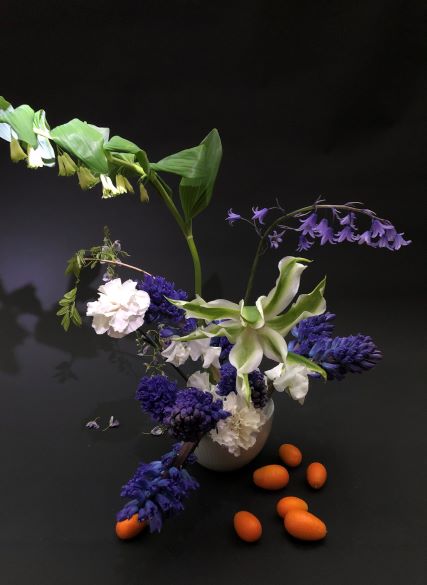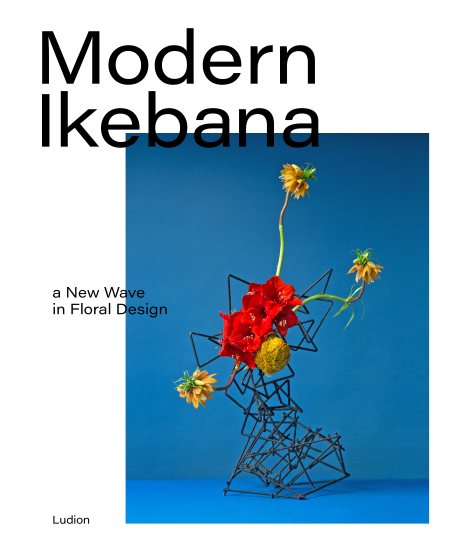Blumenhaus Collaborator
Victoria Gaiger
Rakesprogress

Ikebana has something for everyone: if you are looking for order you can follow the rules, if you are looking for meditative practice it offers that in spades and if you are simply wanting to celebrate the forms you see in nature it allows you to do all of that.
- in the book, Modern Ikebana - A new wave in Floral design, Victoria Gaiger
Ikebana may have its roots in timeless rituals of the past but its reverence for nature has never felt more relevant than it does in our digitally driven, consumer obsessed 21st century. This art, designed to flow with the seasons and move both the viewer and the practitioner, comes freighted with meaning. The whole point is to remind us of our fragile connection to Mother Nature in a tangible, thoughtful and spiritual way.
Ikebana is directly descended from the ritual flower offerings made in Buddhist temples from ancient China. Bt it was the arrival of Zen Buddhism in Japan the 12th century and the development of Wabi-Sabi that gave us ikebana as we understand it today. Wabi Sabi is the Japanese philosophy that seeks the beauty to be found in imperfections and impermanence - and so the imperfections in the bend of a stem, the thorny tangles and shapes of a branch or the quiet simplicity of a wild flowers are celebrated in this floral art.
With the explosion of the floral industry and the rise of Flower artists in the past 10 years there has been a rise in the influence of ikebana in their artistic practice. This influence is sometime subtle but it has at its heart some of the philosophy from the ancient traditions in the form or the reverence of the materials used.
Ikebana has something for everyone: if you are looking for order you can follow the rules, if you are looking for mediative practice it offers that in spades and if you are simply wanting to celebrate the forms you see in nature it allows you to do all of that. Just by slowing down, taking time to look at each flower and recognising its role in the arrangement brings an inner peace. The final composition is made up of the physical space the flowers create and the negative spaces in between. Both take on equal importance.
As Azuma Makoto - one of the foremost floral artists today - said in Modern Ikebana ( our book) “ once you cut a flower it starts to die - it will gradually fade…But when it has been cut and placed, there is a moment of wonder. You have to respect the flower when you are cutting it. There is a spiritual feeling. Its all about the life of that flower..”

1. Please provide a brief introduction to yourself
I’m the founder and creative director/editor of rakesprogress and rakes sense magazine. My husband, Tom, and I launched the magazine in the summer of 2016 and the business has grown from strength to strength. We no longer just publish magazines but we are also a creative studio which works on other projects - books, brand magazines, creative concepts for campaigns and we also create floral installations of our own for exhibitions, stores and shows. We recently also published a book on Modern ikebana which looks at floral artists around the world that use ikebana as inspiration
2. Can you describe your creative process?
I always find this question difficult as I'm not always sure how I get to the final result - on a magazine its a collaborative process, as are books and shoots - but as a florist when you are working on your own its down to materials, mood, and light . It is trial and error and of course it completely depends on the brief and the availability of materials - I’m not a trained florist so am still learning as I go along. I’d like to think that the process of creating will be a continuous journey of discovery!
3. How do you define your style?
My style is eclectic and at some times messy and chaotic. I like asymmetry and I like to use pops of colour or unusual pairings to bring an arrangement to life. Colours, scent and textures are also very important
4. Where do you source inspiration and which flowers inspire you the most?
Inspiration comes from anywhere and everywhere - nature, the garden, changing light and the shapes of shadows, books, films, art exhibitions, artists, textures and fabrics….a single flower can inspire you or wind moving through a field of grass.
I can’t pick a favourite flower - there are some which go in and out of fashion but on the whole if you stop and examine any flower the complexity of nature’s design is astonishing and beautiful in nearly all its forms. I do like fragranced flowers - the smell of blossom, Lilly of the valley, lilacs, paper whites, the soft smell of primroses, bluebells, daffodils, honeysuckle, jasmine, rose scented geraniums and fragranced roses all bring an extra dimension to any arrangement
5. If you were one flower what would it be?
Another difficult question - if its a reflection on my character then something that’s not too showy, something that is quiet. I love the smell of violets and so perhaps a wild violet in early spring
6. Do you hold any scent memories, or wish to share an anecdote related with flowers?
I have so many scent memories - as a child I lived abroad so have vivid memories of the smell of the earth after it had rained (petrichor), the scent of mimosa trees, the softest scent of oleander, the smell of spices and scents in the souk in Sudan, my grandfather’s rose garden in Coventry , honeysuckle and damp ferns in Cornwall and also the scent of my children when they were babies - I have so many more scent memories - too many to mention here!
7. Do you have a favourite garden, place or country related with flowers?
I don’t think I have a favourite garden. There are so many incredible gardens everywhere from the smallest allotment space to wild balconies to vast planned gardens. I would say that the work and gardens of designers such as Tom Stuart-Smith and Dan Pearson are completely inspirational as are the meadows created by Nigel Dunnett. I recently (pre-covid) interviewed and visited the designer Roland Mouret garden - a magical space in the heart of Suffolk.
Christin Louboutin’ iris, peonies and wisteria were amazing in his garden in France and I’m looking forward to seeing the rose gardens owned by the fragrance brand Skandinavisk which we have planned for a future issue.
There are definitely gardens that made a huge impression on me - Derek Jarman’s garden in Dungeness taught me a garden can be anything you want it to be. Then various gardens of my childhood - one in Cornwall where we had an orchard with wild flowers and a stream running through it; a garden we had abroad in Vanuatu, a tropical garden which had wild orchids growing on trees, bougainvillea and a huge variety of fruits which we could pick and eat as we played; and a dry garden we had in North Africa with lime and mandarin trees - the scent of which takes me straight back there, to climbing a tree when I was about 10!
8. In your opinion how do flowers make the world a better place?
We can obviously live without cut flowers but there is a tangible shift when flowers are added to a room. They add another dimension and vibrancy. Something changes to the energy of a room. They are without doubt incredibly important - without them we wouldn’t have fragrance - they remind us of the beauty and changing seasons of nature, they add scent and mood to a room, they cannot fail to bring joy to the recipient and they remind us of the cyclical nature and the beauty in every stage of life - from bud through to decay. They are also given at every stage of life
Ikebana takes years to understand and master but at a very simplistic level Ikebana usually starts with three main components - to represent Heaven, man and earth - and requires different length stems in order to express this
Recipe
One ceramic bowl
One Kenzan ( floral pin holder)
- BLUE HYACINTH 5-8
- DIANTHUS x 2
- WISTERIA x 1 branch
- TULIP x 1
- CALAMONDIN ( kumquats) x 7
- POLYGONATUM MULTIFLORUM ( SOLOMANS SEAL) X 1 STEM
- Peony x 1 stem ( unused)
- Bluebell -x 1
- Sweet pea x 1
To begin with make sure you make clean cuts diagonally along the stems of the flowers with sharp floral scissors or secateurs - stripping away any foliage you don’t want - I like to use a shallow ceramic bowl for the arrangement as it gives you width to a composition.
Add the Kenzan (also known as a flower frog ) to the bowl (you can secure it in place with a special floral tack that stops it from moving) then fill the bowl so that the “ frog” is covered in water.
You can then start building up your arrangement.
Determine the stems you’d like to use. The shapes will help you compose the arrangement. Look for a tall stem to give the tallest height - I’ve used a stem of Solomon’s seal (a shade loving plant with small bell like flowers )
I use a tulip for the medium height and then I used hyacinth for the smallest stems.
Once the initial framework is there you can either leave it if it looks and feels right or you can add to it. I continued with white dianthus and wisteria. A finished the composition with a handful of kumquats!
Take your time - you can add and subtract but use your tallest stem as a guide.
Don’t stress, the most important thing is to enjoy the mediative time it takes to find, explore and study the flowers - then add them as you see them fitting in the arrangement.
One the flowers are prepared and ready - there is is no real right or wrong here as we are using ikebana as an inspiration - so just go for it !